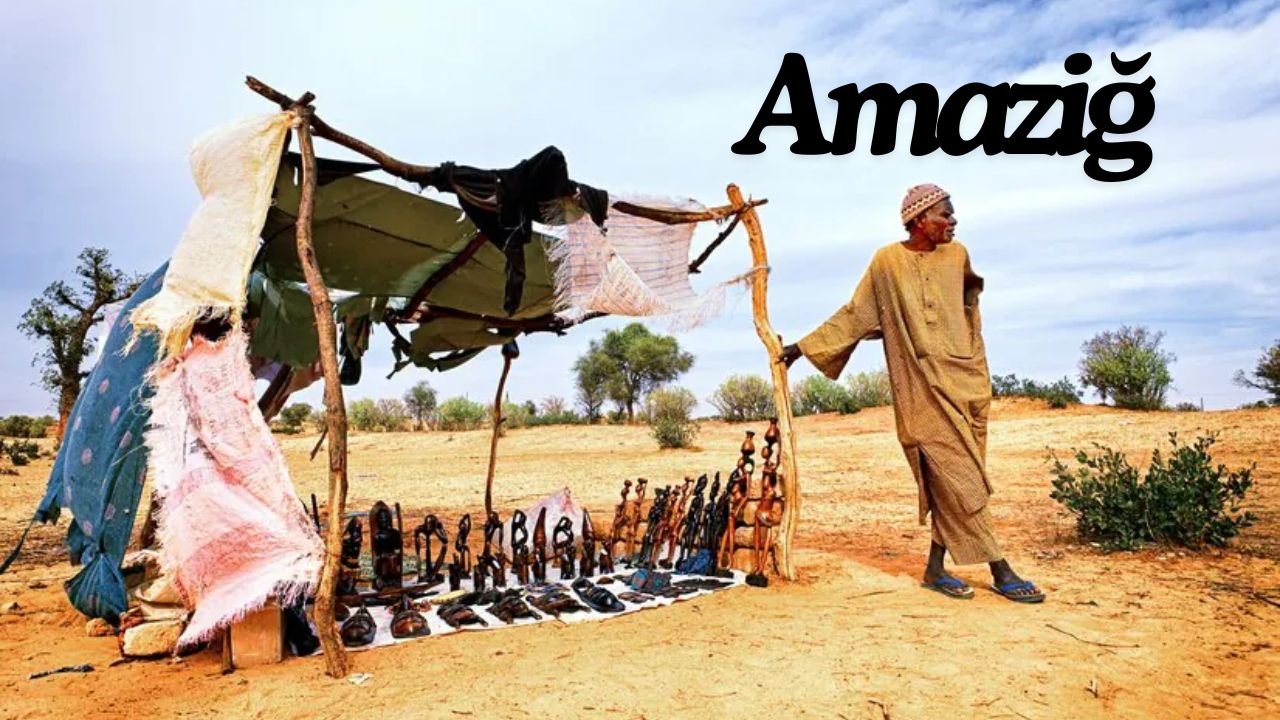Welcome to a deep exploration of the Amaziğ identity, a rich and intricate tapestry woven through millennia of history, culture, and resilience. The Amaziğ people, often known as Berbers, are indigenous to North Africa and have significantly influenced the social and cultural landscape of the region. This blog post aims to take you on a historical and cultural journey, tracing the roots of the Amaziğ people from their prehistoric origins to their present-day revival efforts.
In this comprehensive guide, you will learn about the Amaziğ’s prehistoric roots, their role in ancient civilizations, the significance of the Tamaziğt language, and their unique cultural expressions. We will also explore the social structure and values that bind the Amaziğ community, the contemporary challenges they face, and the inspiring efforts to preserve their rich heritage for future generations. By the end of this post, you will have a profound appreciation for the Amaziğ identity and its enduring legacy.
Historical Background
Prehistoric Roots
The history of the Amaziğ people dates back thousands of years, long before written records. Archaeological findings suggest that North Africa was home to some of the earliest human settlements, with evidence of stone tools and cave paintings that provide a glimpse into the lives of these ancient inhabitants. These prehistoric roots lay the foundation for the Amaziğ’s enduring connection to the land.
The Tassili n’Ajjer cave paintings in Algeria, for example, depict scenes of daily life, hunting, and religious rituals that offer valuable insights into the early Amaziğ culture. These artworks, dating back to around 6000 BCE, highlight the Amaziğ’s early artistic expressions and their deep relationship with nature. The prehistoric roots of the Amaziğ people are a testament to their resilience and adaptability in the face of changing environments and challenges.
Ancient Civilizations
As the Amaziğ communities evolved, they became integral to the ancient civilizations of North Africa. The Amaziğ played a significant role in the rise and fall of powerful empires such as Carthage and Numidia. Carthage, founded by the Phoenicians around 814 BCE, became a major trading hub, and the Amaziğ people were active participants in its economic and military activities.
Numidia, an ancient Amaziğ kingdom, emerged as a significant power during the Roman era. The Numidian kings, such as Masinissa and Jugurtha, established strong alliances with Rome while maintaining their cultural identity. The Amaziğ influence in Numidia extended to agriculture, architecture, and governance, leaving a lasting legacy that can still be seen in the region today.
Survival Through Conquests
Throughout history, the Amaziğ people faced numerous invasions and conquests by foreign powers, including the Romans, Arabs, and Ottomans. Despite these challenges, the Amaziğ culture endured, adapting and assimilating elements of the conquerors while preserving their unique heritage.
During the Roman conquest of North Africa, the Amaziğ people managed to maintain their tribal structures and cultural practices. The Arab invasion in the 7th century CE brought Islam to the region, which significantly influenced the Amaziğ way of life. However, the Amaziğ managed to blend Islamic traditions with their indigenous beliefs, creating a unique religious and cultural synthesis.
The Amaziğ’s ability to survive and thrive through centuries of conquests is a testament to their resilience and determination. Their story is one of adaptation and continuity, as they navigated the complexities of a changing world while holding on to their cultural identity.
Language and Identity
Tamaziğt Language
The Tamaziğt language, also known as Berber, is a vital component of the Amaziğ identity. It is a diverse and ancient language with several dialects spoken across North Africa. Tamaziğt is not only a means of communication but also a repository of the Amaziğ’s cultural heritage, oral traditions, and historical narratives.
The language comprises various dialects, such as Tamazight, Tarifit, and Tashelhit, each with its regional variations. Despite the linguistic diversity, these dialects share common roots and grammatical structures, reflecting the unity and diversity of the Amaziğ people. Tamaziğt is written using the Tifinagh script, an ancient alphabet that has been revitalized in recent years as part of efforts to preserve and promote the language.
Efforts for Language Preservation
In recent years, there has been a growing movement to preserve and revitalize the Tamaziğt language. Governments, non-profit organizations, and grassroots movements have collaborated to promote the teaching and use of Tamaziğt in schools, media, and public life. These efforts are crucial in ensuring that the language continues to thrive and be passed down to future generations.
Countries like Morocco and Algeria have taken significant steps to recognize Tamaziğt as an official language, integrating it into the national education system and media. Cultural centers, language courses, and online resources have also been established to support language learners and promote the use of Tamaziğt in everyday life.
Preserving the Tamaziğt language is not just about safeguarding a means of communication; it is about maintaining a connection to the Amaziğ’s rich cultural heritage and identity. By keeping the language alive, the Amaziğ people can continue to celebrate their history and traditions while adapting to the modern world.
Cultural Expressions
Music and Dance
Music and dance are integral to Amaziğ culture, serving as expressions of identity, storytelling, and communal bonding. Traditional Amaziğ music features a variety of instruments, such as the bendir (frame drum), the guembri (a three-stringed lute), and the zurna (a type of oboe). These instruments create a distinctive sound that is both rhythmic and melodic, reflecting the rich musical heritage of the Amaziğ people.
Dance is equally important, with traditional dances often performed during festivals, weddings, and other communal events. The Ahidus dance, for example, is a circle dance performed by men and women, accompanied by singing and drumming. The dance is a celebration of unity and harmony, showcasing the Amaziğ’s connection to their community and environment.
Art and Textiles
Artistic expression is a significant aspect of Amaziğ culture, with unique styles and techniques passed down through generations. Amaziğ art includes intricate jewelry, pottery, and metalwork, often adorned with geometric patterns and symbols that hold cultural and spiritual significance.
Textiles are another prominent form of artistic expression, with Amaziğ women traditionally weaving rugs, blankets, and clothing using techniques that have been preserved for centuries. The vibrant colors and intricate patterns of Amaziğ textiles reflect the creativity and skill of the artisans, as well as the cultural stories and symbols embedded in their designs.
Festivals and Ceremonies
Amaziğ festivals and ceremonies are vibrant celebrations of culture, community, and tradition. One of the most important festivals is Yennayer, the Amaziğ New Year, which marks the beginning of the agricultural calendar. Celebrated in January, Yennayer is a time for feasting, music, and dancing, as well as honoring ancestors and the natural world.
Another significant event is the Imilchil Marriage Festival, a unique celebration where young Amaziğ men and women gather to find potential marriage partners. The festival, held in the remote village of Imilchil in Morocco, is a colorful and joyous occasion, featuring traditional music, dance, and elaborate costumes.
These festivals and ceremonies are essential in preserving and promoting Amaziğ culture, providing opportunities for the community to come together and celebrate their shared heritage.
Social Structure and Values
Tribal Solidarity
Tribal solidarity is a fundamental aspect of Amaziğ society, with kinship and familial connections playing a crucial role in social organization and identity. Amaziğ tribes, or “Imazighen,” are often organized into extended family units, with strong bonds of loyalty and mutual support.
This sense of tribal solidarity extends beyond immediate family members, encompassing the wider community and fostering a culture of cooperation and collective responsibility. Tribal leaders, known as “Amghar,” play a vital role in maintaining social cohesion, mediating disputes, and representing the tribe in broader political and social contexts.
Connection to the Land
The Amaziğ people have a deep and enduring connection to the land, which is central to their cultural identity and way of life. Traditionally, the Amaziğ have been farmers, herders, and artisans, relying on the natural resources of their environment for sustenance and livelihood.
This close relationship with the land is reflected in Amaziğ cultural practices, such as agricultural rituals, seasonal festivals, and sustainable land management techniques. The Amaziğ’s connection to the land is not just practical but also spiritual, with a profound respect for the natural world and its cycles.
Gender Roles and Family
Gender roles within Amaziğ society have traditionally been defined by cultural norms and social expectations. Historically, men were responsible for activities such as farming, herding, and trade, while women managed household duties, childcare, and artisanal crafts like weaving and pottery.
In recent years, however, there has been a shift towards greater gender equality and empowerment within Amaziğ communities. Women are increasingly participating in education, professional careers, and community leadership roles, challenging traditional gender norms and contributing to the overall development of their society.
Family remains a central pillar of Amaziğ society, with strong emphasis on mutual support, respect, and intergenerational bonds. The family unit is seen as the foundation of social stability and cultural continuity, with each member playing a vital role in maintaining the well-being and harmony of the household.
Contemporary Challenges and Revival
Historical Marginalization
Throughout history, the Amaziğ people have faced various forms of marginalization and discrimination, as foreign powers and dominant cultures sought to suppress their identity and traditions. This marginalization has often resulted in social, economic, and political challenges, including limited access to education, healthcare, and economic opportunities.
Despite these obstacles, the Amaziğ have demonstrated remarkable resilience and determination in preserving their culture and advocating for their rights. The struggle for recognition and equality has been a long and arduous journey, but it has also been marked by significant achievements and milestones.
Cultural Revival
In recent decades, there has been a resurgence of interest in Amaziğ culture and heritage, driven by grassroots movements, cultural organizations, and international support. Efforts to revive and sustain Amaziğ culture have focused on areas such as language preservation, cultural education, and the promotion of traditional arts and crafts.
Cultural festivals, film screenings, exhibitions, and academic conferences have provided platforms for raising awareness and celebrating Amaziğ identity. These initiatives have not only strengthened the Amaziğ community but also fostered a broader appreciation for their rich cultural heritage.
Political and Social Movements
The pursuit of political and social rights has been a central aspect of the Amaziğ’s contemporary revival. Over the years, various movements and organizations have emerged to advocate for Amaziğ recognition, representation, and autonomy within their respective countries.
In Morocco, for example, the Royal Institute of Amazigh Culture (IRCAM) was established in 2001 to promote the Tamaziğt language and culture. Similarly, in Algeria, the recognition of Tamaziğt as an official language in 2016 marked a significant milestone in the Amaziğ’s struggle for cultural and linguistic rights.
These political and social movements have played a crucial role in advancing the Amaziğ cause, paving the way for greater inclusivity and respect for their cultural identity.
The Future of Amaziğ Culture
Preservation Initiatives
The preservation of Amaziğ culture is a collective effort that involves various stakeholders, including governments, non-profit organizations, academics, and community members. Numerous initiatives are underway to document, protect, and promote Amaziğ heritage, ensuring it remains vibrant and relevant for future generations.
Projects such as the digitization of Amaziğ manuscripts, the creation of cultural archives, and the establishment of community museums are just a few examples of the ongoing efforts to safeguard Amaziğ culture. These initiatives are essential in preserving the knowledge, traditions, and artistic expressions that define the Amaziğ identity.
Inspiring Future Generations
The younger generation plays a vital role in the continuation and revitalization of Amaziğ culture. Education and awareness programs have been developed to engage young Amaziğ individuals with their heritage, encouraging them to take pride in their identity and contribute to its preservation.
Youth-led initiatives, cultural clubs, and creative platforms have provided opportunities for young Amaziğ people to explore and express their cultural roots. By fostering a sense of belonging and cultural pride, these efforts inspire future generations to carry forward the legacy of their ancestors.
Looking Ahead
The future of Amaziğ culture is bright, with continued efforts to promote and celebrate its unique heritage. As the Amaziğ community navigates the challenges and opportunities of the modern world, their cultural identity remains a source of strength and resilience.
By building on the achievements of the past and embracing new possibilities, the Amaziğ people are poised to thrive and contribute to the rich tapestry of global cultures. The preservation and promotion of Amaziğ culture is not just a matter of heritage but a testament to the enduring spirit of a people who have shaped and enriched the history of North Africa.
You May Also Like: The Enigmatic Beholderen: A Linguistic Journey
Conclusion
The Amaziğ identity is a complex and multifaceted tapestry, woven through millennia of history, culture, and resilience. From their prehistoric roots to their contemporary revival, the Amaziğ people have demonstrated a remarkable ability to adapt and thrive while preserving their unique heritage.
As we have explored in this blog post, the Amaziğ culture encompasses a rich array of elements, including language, music, dance, art, festivals, and social values. Despite facing historical marginalization and challenges, the Amaziğ community continues to advocate for their rights, celebrate their identity, and inspire future generations.
For history enthusiasts, cultural anthropologists, and language preservationists, the Amaziğ story offers valuable insights into the resilience and creativity of indigenous cultures. By supporting preservation initiatives, engaging with Amaziğ heritage, and promoting cultural awareness, we can contribute to the continued vitality of the Amaziğ identity.
Frequently Asked Questions
What is Amaziğ culture?
Amaziğ culture refers to the traditions, languages, arts, and social practices of the Amazigh people, Indigenous to North Africa. It encompasses a rich heritage that includes unique music, dance, art, and festivals, reflecting the history and identity of the Amaziğ community.
Why is the preservation of Amaziğ culture important?
Preserving Amaziğ culture is vital for maintaining the diversity of global cultures. It supports the continuation of the Amaziğ identity, fosters pride among future generations, and contributes to the cultural richness of North Africa as a whole. Additionally, it helps mitigate the effects of historical marginalization faced by the community.
How is the Amaziğ language being preserved?
Efforts to preserve the Tamaziğt language include educational programs, the recognition of Tamaziğt as an official language in certain countries, and initiatives led by organizations like the Royal Institute of Amazigh Culture (IRCAM) in Morocco. Language revitalization plays a critical role in sustaining the culture.
What challenges does the Amaziğ community face today?
The Amaziğ community continues to face social, economic, and political challenges, including limited access to education and job opportunities, as well as the ongoing struggle for recognition and autonomy. These issues stem from historical marginalization and can impact cultural preservation efforts.
How can I support Amaziğ culture?
You can support Amaziç culture by engaging in cultural awareness initiatives, participating in local events celebrating Amaziğ heritage, supporting organizations dedicated to the preservation of their culture, and advocating for the rights of the Amaziğ people within your community and beyond.










